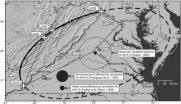(Press-News.org) Boulder, CO, USA – Climate change and extreme weather events grab the headlines, but there is another, lesser known, global change underway on land, in the seas, and in the air: acidification.
It turns out that combustion of fossil fuels, smelting of ores, mining of coal and metal ores, and application of nitrogen fertilizer to soils are all driving down the pH of the air, water, and the soil at rates far faster than Earth's natural systems can buffer, posing threats to both land and sea life.
"It's a bigger picture than most of us know," says Janet Herman of the Department of Environmental Sciences at University of Virginia in Charlottesville.
Herman and her colleague, Karen Rice of the USGS, discovered that despite the fact that they worked on different kinds of acidification in the environment, they were not well informed about the matter beyond their own specialties. So they have done an extensive review of science papers about all kinds of environmental acidification and are presenting their work in a poster session on Tuesday, 6 Nov., at the annual meeting of the Geological Society of America (GSA) in Charlotte, North Carolina, USA.
Acidification is both a local and global problem, since it can be as close as a nearby stream contaminated by mine tailings or as far-reaching as the world's oceans, which are becoming more acidic as sea water absorbs higher concentrations of carbon dioxide that humans dump into the atmosphere by burning fossil fuels.
Coal gives a double whammy by being the biggest contributor of anthropogenic carbon dioxide to the global atmosphere as well as creating regional acidification. Coal burning is famous for creating acid rain, which had dramatic environmental impacts on forests, streams, and lakes in eastern North America and Europe and led to major policy changes.
"It's not at all clear that other regions are considering such policy restrictions to be important," Herman says, regarding places where population growth is expected to increase acidifying activities.
Normally, acids in the environment are buffered by alkaline compounds released by the weathering of minerals in rocks. The problem today, according to Herman, is that the rate of acidification by human activities has outstripped the weathering rate and buffering capacity of the planet.
In their work, Herman and Rice look at the population projections by country over the next four decades to see where the increased industrialization and agriculture will likely lead to new acidification hot spots. Their hope is that by doing this people can anticipate the problem and plan to mitigate the harmful environmental effects, says Herman.
### WHAT: Acidification of Earth: An Assessment across Mechanisms and Scales
WHEN: 9 a.m. to 6 p.m., Tuesday, 6 Nov.
WHERE: Booth #67, Charlotte Convention Center: Hall B
ABSTRACT: https://gsa.confex.com/gsa/2012AM/finalprogram/abstract_207495.htm
CONTACT:
Janet Herman
University of Virginia, Charlottesville
+1 (434) 960-1709
The many additional newsworthy presentations about acidification include the following:
Session No. 157
Geochemistry (Posters)
https://gsa.confex.com/gsa/2012AM/finalprogram/session_31996.htm
Charlotte Convention Center, Exhibit Hall B
9 a.m. to 6 p.m., Tuesday, 6 Nov.
Session No. 190
Special Session: Recent Advances in Carbonate Sedimentology and Stratigraphy: In Memory of
Gerald M. Friedman
https://gsa.confex.com/gsa/2012AM/finalprogram/session_30818.htm
Charlotte Convention Center, Room 203B
1:30 p.m. to 5:30 p.m., Tuesday, 6 Nov.
Session No. 222
The Evolution of Biomineralization
https://gsa.confex.com/gsa/2012AM/finalprogram/session_30391.htm
Charlotte Convention Center, Room 217BC
8 a.m. to noon, Wednesday, 7 Nov.
Find out what else is new and newsworthy by browsing the complete technical program schedule at https://gsa.confex.com/gsa/2012AM/finalprogram/.
To identify presentations in specific areas of interest, search topical sessions by discipline categories or sponsors using the drop-down menus at www.geosociety.org/meetings/2012/sessions/topical.asp, or use your browser's "find" feature to search for keywords or convener names.
Representatives of the media and public information officers from universities, government agencies, and research institutions, may participate in technical sessions, field trips, and other special events. Eligible media personnel will receive complimentary registration and are invited to use GSA's newsroom facilities while at the meeting. Journalists and PIOs must pay for any short courses or field trips in which they wish to participate.
For information on media eligibility, go to www.geosociety.org/meetings/2012/media.htm. Media personnel may register onsite in the GSA Newsroom (room 204) at the Charlotte Convention Center. Wireless Internet access and a quiet space for interviews will be provided in the newsroom, along with beverages and light snacks throughout the day.
Newsroom Hours of Operation
Saturday, 3 Nov., 3 p.m. to 5 p.m.
Sunday, 4 Nov., through Tuesday, 6 Nov., 7:30 a.m. to 6 p.m.
Wednesday, 7 Nov., 7:30 a.m. to 5:30 p.m.
Newsroom telephone number (incoming calls): +1-704-339-6207 (starting Saturday afternoon).
Contact Christa Stratton, GSA Director of Communications & Marketing, for additional information and assistance.
www.geosociety.org/meetings/2012/
SAN DIEGO – (Monday, November 5, 2012) – Heart disease risk factors are widespread among Hispanic/Latino adults in the United States, with 80 percent of men and 71 percent of women having at least one risk factor for heart disease, according to a San Diego State University study funded by the National Institutes of Health. These percentages are much higher than the general population, where approximately 49 percent of adults have at least one major risk factor for heart disease and stroke.
Findings from the Hispanic Community Health Study/Study of Latinos (HCHS/SOL), ...
If you look old, your heart may feel old, according to research presented at the American Heart Association's Scientific Sessions 2012.
In a new study, those who had three to four aging signs — receding hairline at the temples, baldness at the head's crown, earlobe crease, or yellow fatty deposits around the eyelid (xanthelasmata) — had a 57 percent increased risk for heart attack and a 39 percent increased risk for heart disease.
"The visible signs of aging reflect physiologic or biological age, not chronological age, and are independent of chronological age," said ...
Adults 18-24 years old with high blood pressure were 28 percent less likely to be diagnosed during doctor visits than those 60 and older, according to findings presented at the American Heart Association's Scientific Sessions 2012.
"These young patients come to the clinic and their blood pressure is recorded," said Heather Johnson, M.D., lead researcher of the study. "They have high blood pressure, but there's no documentation of a diagnosis. We wanted to find out why."
Researchers examined electronic health records of 13,593 men and women who were at least 18 years ...
No matter what climate you live in, you're more likely to die of heart-related issues in the winter, according to research presented at the American Heart Association's Scientific Sessions 2012.
"This was surprising because climate was thought to be the primary determinant of seasonal variation in death rates," said Bryan Schwartz, M.D., lead author of the study.
Researchers at Good Samaritan Hospital in Los Angeles analyzed 2005-08 death certificate data from seven U.S. locations with different climates: Los Angeles County, Calif.; Texas; Arizona; Georgia; Washington; ...
Combining cancer medication with a drug for erectile dysfunction and one for heart transplants helped kill cancer cells and protected the heart from damage, in a study presented at the American Heart Association's Scientific Sessions 2012.
For decades, doxorubicin has been a powerful anti-cancer treatment for various human cancers, including breast, ovarian, colon and prostate. But its use has been limited due to harmful, possibly irreversible effects on the heart.
In this study, using cell and animal models, researchers found that sildenafil alone or in combination with ...
The 2011 Mineral, Virginia M-5.8 earthquake was felt over an extraordinarily large area. A new study details landslides triggered by the earthquake at distances four times greater and over an area 20 times larger than previously documented for M-5.8 earthquakes worldwide.
The study, to be published in the December issue of the Bulletin of the Seismological Society of America (BSSA), describes physical confirmation of previous observations that ground shaking from earthquakes in the eastern U.S. travels farther than in the western U.S, a plate-boundary region.
U.S. ...
A multi-institutional team of researchers has sequenced the DNA of 6,700 exomes, the portion of the genome that contains protein-coding genes, as part of the National Heart, Lung and Blood Institute (NHLBI)-funded Exome Sequencing Project, one of the largest medical sequencing studies ever undertaken.
Scientists participating in the project initially expected that individual rare variants would have a greater effect on over 80 heart, lung and blood related traits and diseases of high public health significance, said Suzanne M. Leal, Ph.D., professor and director, Center ...
SALT LAKE CITY – Cardiology researchers at the Intermountain Medical Center Heart Institute have found that approximately 75 percent of patients taking two common blood-thinning drugs may be receiving the wrong dosage levels, according to a new study.
This could put them at risk for serious problems like uncontrolled bleeding or developing blood clots.
Millions of Americans with coronary artery disease take one of the two drugs — clopidogrel (Plavix) and prasugrel (Effient) — to prevent harmful blood clots that can cause a stroke or heart attack. Current guidelines ...
Researchers from Aarhus University, Denmark, have now discovered an important mechanism behind one of our most fundamental lines of immune function. The discovery has been published in the esteemed scientific journal, The Journal of Immunology, where it has been highlighted as a top story.
In collaboration with colleagues from USA and Turkey, they have discovered exactly which enzymes collaborate in the first line of the immune defence. Thus, they answer a central question about the so-called complement system, which has been a focal point of the scientific field for the ...
VIDEO:
Figaro, a Goffin's Cockatoo, makes and uses a tool.
Click here for more information.
Goffin's cockatoos are a highly playful and curious Indonesian cockatoo species. Therefore, cognitive biologists are now using them as a model species to investigate intelligent behaviour in birds. Together with researchers from the University of Oxford, Alice Auersperg and Birgit Szabo from the Department of Cognitive Biology at the University of Vienna have made a sensational discovery: ...

